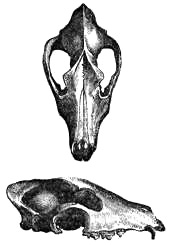Curragh of Kildare
In Leinster the forests had been cleared at an earlier period; and the country being less mountainous, was more easily cultivated. But this portion of Ireland contained the well-known Curragh of Kildare, which has its history also, and a more ancient one than its modern visitors are likely to suppose. The Curragh is mentioned for the first time in the Liber Hymnorum, in a hymn in praise of St. Brigid. The Scholiast in a contemporary gloss says: "Currech, a cursu equorum, dictus est." It is also mentioned in Cormac's Glossary, where the etymology is referred to running or racing. But the most important notice is contained in the historical tale of the destruction of the mansion of Dá Derga.[1] In this,Connairé Môr, who was killed A.D. 60, is represented as having gone to the games at the Curragh with four chariots. From this and other sources we may conclude, that chariot-races preceded horse-races in ancient Erinn, and that the Curragh has been used as a place of public amusement for the last 2,000 years.
It is also mentioned in Cormac's Glossary, where the etymology is referred to running or racing. But the most important notice is contained in the historical tale of the destruction of the mansion of Dá Derga.[1] In this,Connairé Môr, who was killed A.D. 60, is represented as having gone to the games at the Curragh with four chariots. From this and other sources we may conclude, that chariot-races preceded horse-races in ancient Erinn, and that the Curragh has been used as a place of public amusement for the last 2,000 years.
It would appear that every province in Ireland possessed an Aenach or "fair-green," where the men assembled to celebrate their games and festivals. In an old list of Irish Triads, the three great Aenachs of Ireland are said to have been Aenach Crogan, in Connaught; Aenach Taillten, in Meath; and Aenach Colmain, the Curragh. The last would appear, however, to have been frequented by persons from all parts of Ireland; and it is not a little strange that it should still be used in a similar manner as a place of public amusement. Ireland in the tenth century and Ireland in the nineteenth form a painful contrast, notwithstanding the boasted march of intellect. The ancient forests have been hewn down with little profit [2] to the spoiler, and to the injury in many ways of the native. The noble rivers are there still, and the mountains look as beautiful in the sunsets of this year of grace as they did so many hundred years before; but the country, which was in "God's keeping" then, has but little improved since it came into the keeping of man; for the poor tenant, who may be here to-day, and to-morrow cast out on the wayside, has but substituted ill-fenced and ill-cultivated fields for wide tracts of heather and moorland, which had at least the recommendation of attractive scenery, and of not suggesting painful reflections.
The most formidable, if not the largest, of the carnivora in this island, was the brown bear. The wolf lingered on until the beginning of the last century; and the Irish greyhound has passed with it also. The gigantic Irish elk, Cervus megaseros, belongs more to the palaeontologist than to the historian, as it is supposed to have existed only in pre-historic times. A smaller variety has been found in peat overlaying the clay, from which it is inferred that some species may have been contemporary with the human race. The horse co-existed with the elephant. The red deer was the principal object of chase from an early period. The wild boar found abundant food from our noble oaks; and the hare, the rabbit, the goat, and the sheep supplied the wants of the Celt in ancient as in modern times. But the great wealth of Ireland consisted in her cows, which then, as now, formed a staple article of commerce. Indeed, most of the ancient feuds were simply cattle raids, and the successful party signalized his victory by bearing off the bovine wealth of the vanquished enemy.
It is impossible exactly to estimate the population of Ireland at this period with any degree of reliable exactitude. The only method of approximating thereto should be based on a calculation of the known or asserted number of men in arms at any given time. When Roderic and his allies invested the Normans in Dublin, he is said to have had 50,000 fighting men. Supposing this to include one-fourth of all the men of the military age in the country, and to bear the proportion of one-fifth to, the total number of the inhabitants, it would give a population of about a million, which would probably be rather under than over the correct estimate.
Notes
[1] Dá Derga.—See an interesting Essay on the Curragh of Kildare, by Mr. W. M. Hennessy, read before the R. I. A., February 26, 1866.
[2] Profit.—-The trustees of the estates forfeited in 1688 notice this especially. Trees to the value of £20,000 were cut down and destroyed on the estate of Sir Valentine Brown, near Killarney, and to the value of £27,000 on the territory of the Earl of Clancarty. Some of these trees were sold for sixpence a piece.
